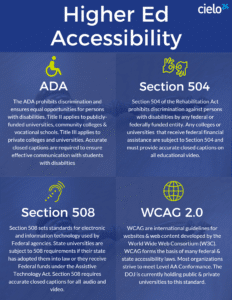Your Higher Education Video Captioning Plan Courses should be designed from the very beginning thinking…

How to Advocate for a University Video Captioning Budget
Breaking Down the Video Captioning Budget Barrier
There is a widespread lack of institutional awareness around both the legal requirements and the benefits of video captioning for all students. Addressing this issue is key to convincing universities to establish a video captioning budget.
We’ve developed a 2-pronged approach for successfully getting institutional buy-in for video captioning. It starts by clearly outlining the legal requirements for captioning, followed by highlighting the various benefits that video captioning brings to both students and the university.
1. Explain the Legal Requirements
Captioning isn’t just a good idea, it’s required! Review the following laws and note the noncompliance consequences to prepare your argument for a video captioning budget.
ADA

Title II of the ADA prohibits discrimination on the basis of disability in services, programs, and activities provided by State and local government entities. It includes publicly-funded universities, community colleges, and vocational schools.
Entities subject to Title II are required to provide equally effective communication, regardless of the medium chosen. This includes accurate closed captions for all educational videos available to both students and the public.
Title III of the ADA prohibits discrimination on the basis of disability in the full and equal enjoyment of offerings by public accommodations. This includes over five million private establishments, such as restaurants and libraries, as well as private colleges and universities.
Under Title III, Private universities are required to caption all course videos as well as ensure all other course materials and technology are accessible to students with disabilities.
Section 504
Section 504 of the Rehabilitation Act of 1973 prohibits discrimination on the basis of disability in programs conducted by federal agencies, in programs receiving federal financial assistance, in federal employment, and in the employment practices of federal contractors.
Any colleges, universities, or businesses that receive federal funding are subject to Section 504 and must provide accurate closed captions on all educational video.
Section 508
Section 508 establishes requirements for electronic and information technology (EIT) developed, maintained, procured, or used by the Federal government. They are modeled after WCAG 2.0, the international guidelines for web accessibility. Section 508 applies to federal agencies, states who have adopted the standards into their laws, and any state schools who receive Federal funds under the Assistive Technology Act.
Consequences
Failure to comply with these laws does not only hurt students but can be very costly for the university. The DOJ and OCR have investigated over 20 universities in the last decade for violations of Section 504 and the ADA. In all of the cases, universities had to agree to a complete overhaul of their accessibility programs to ensure they provide equal access to students with disabilities.
The most recent lawsuits include those against UC Berkeley for the failure to caption publicly available video and Harvard and MIT for their failure to caption course content. You can read about the most common mistakes made and resulting resolutions here.
TAKEAWAY: Multiple federal laws require accurate closed captioning for course video content available to both students and the public. Failing to caption educational video can lead to an investigation by the DOJ and costly a resolution.
2. Highlight the Numerous Benefits for Students and the University

As discussed in our ebook, Beyond Accessibility: Captioning Benefits in Higher Education, the are multiple benefits to captioning beyond just accessibility compliance.
We’ve found that the key to successfully establishing a video captioning budget is to clearly emphasize the ways in which captions improve student success and benefit the university.
Improved learning outcomes
Captions have been shown to improve student academic performance due to increases in focus, retention, comprehension, and literacy. Robert Keith Collins, a professor of American Indian studies at San Francisco State University, found that his students’ GPAs increased by a full GPA point during a two-year captioning case study. He noted his students were better able to focus, understand, and remember what they learned when the audio was reinforced with captions.
Additional research by Greg McCall and Carmen Craig found that captions significantly improved the reading comprehension skills of secondary school students in Kaneohe, Hawaii. In another study, conducted by Planet Read in India, same-language-subtitling on TV increased the literacy rate of children in the country, doubling the number of functional early-age readers.
Creation of an organized, searchable video library for storing and managing legacy content
As you can see, providing closed captions is a must. The best way to do this is to enlist a full-service video captioning solution that provides more than a simple captioning file. These services, such as time-stamped transcripts and video intelligence, enable your videos to be searchable and organized within your online video platform.
This means both students and faculty can easily find, watch, and share thousands of hours of legacy video content. Making your video library accessible through video data boosts video ROI and ensures content won’t be lost or wasted.
Enable admissions and marketing efforts
In addition to optimizing your video library, video intelligence allows for enhanced reach, discovery, and engagement for any promotional videos used at the university. Video intelligence powers video SEO, improving search ranking results and expanding your potential reach.
Integrated video management
By choosing a full-service video captioning solution, you also ensure that the process will be smooth from start to finish. Comprehensive captioning providers handle the entire captioning process for you, from taking requests from multi-departmental requests to uploading the captioned videos straight to your OVP.
At cielo24, we offer a full-service automated workflow included in the price of our captions, so you don’t have to worry about the managing the video workflow. This saves you time and money while boosting the ROI of university video.
Final Thoughts Regarding Your Video Captioning Budget
To get institutional buy-in, you have to hit them with a one-two punch. First, stress the legal obligation to caption and follow up with all of the added value that captions bring to the table. For more details on accessibility laws, additional benefits and funding resources, download the ebooks below (it’s free!).
- 2017 State & Federal Accessibility Guidelines and Laws for Education
- Beyond Accessibility: Captioning Benefits in Higher Education
- 2017-2018 Grants and Funding Resource
If you are currently investigating captioning providers, feel free to request a quote from cielo24 here.
Happy captioning!



